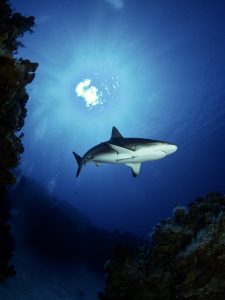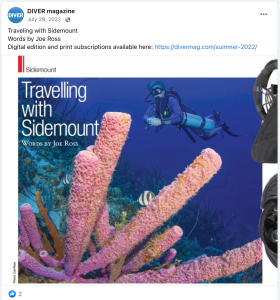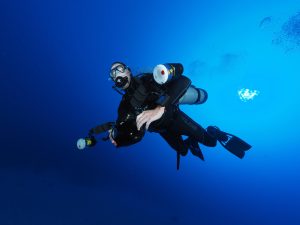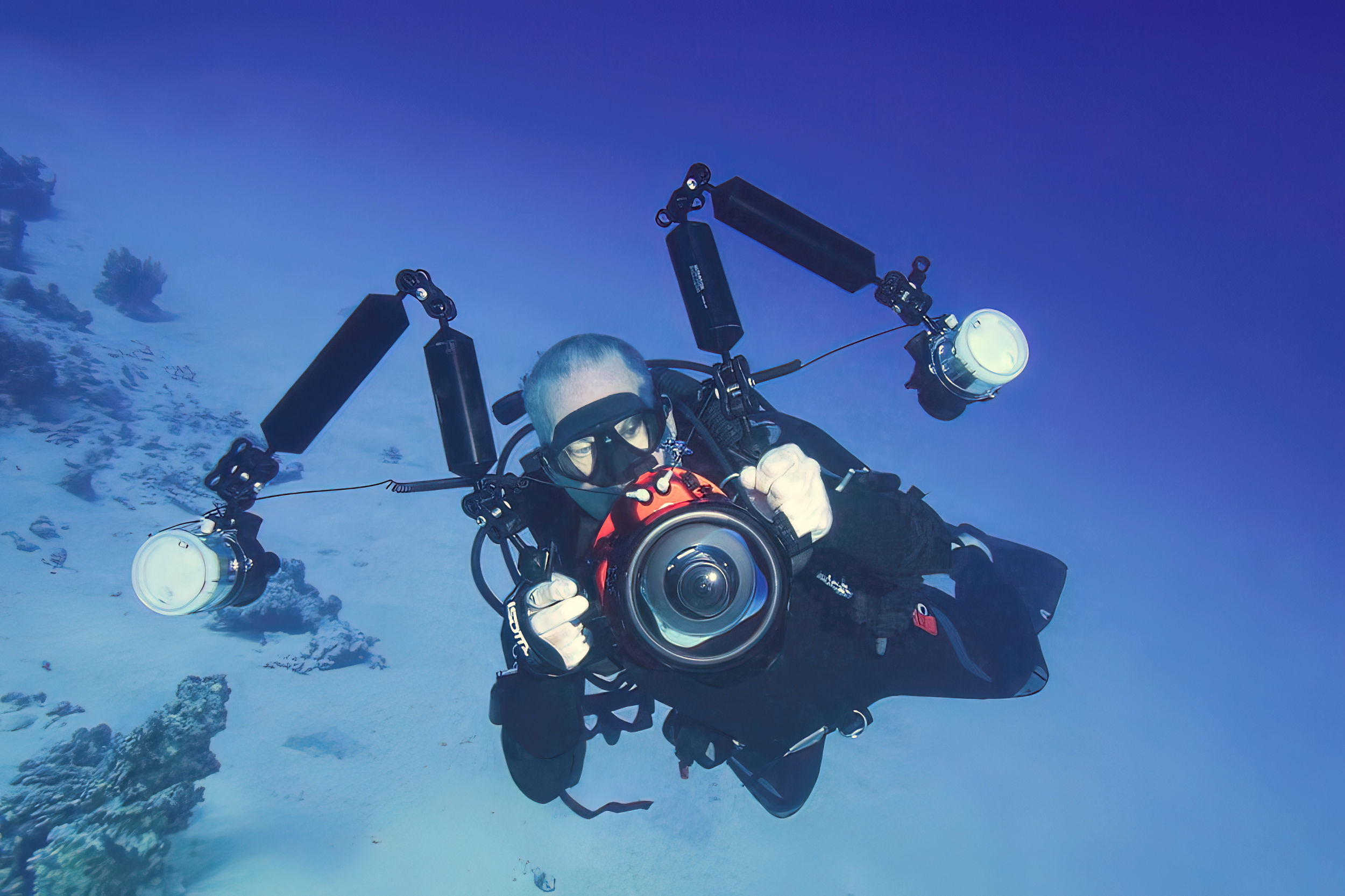Underwater Photographer: Scuba Diver’s Dream Job
Let me start out by saying underwater photography is only part of my job. Howard Hall, Norbert Wu, David Doubilet… When I think of professional underwater photographers, that’s who comes to mind. I’m not that. Those guys (girls) are legends. I’m just a diver that happens to have a pretty great gig.
For a little background, I got certified in 1983, and was diving a few years before that. I learned underwater photography shooting film using, first a used Nikonos II, then a IV and eventually several Nikonos Vs. I learned to push Fujichrome Velvia, and shot almost exclusively, the legendary Nikonos 15mm lens. Those were glorious days!
Since then, I became an instructor, then technical diving instructor. Like a lot of photographers, I dive rebreathers and travel a lot. At least, it feels like a lot. I do about six dive trips a year. Most of these are to places I have always wanted to go. My “jobby-job,” as a friend puts it is running a marketing agency.
Many of our clients are in the dive industry. We are DEMA members and exhibit at every show. We meet a lot of new clients at DEMA, but really, we go to be divers and hang out with friends we’ve made over the years.
As a “pro” most of my photo and video work is promoting either dive resorts, or scuba products. As you might imagine, shooting resorts is dreamy. BUT, and this is a biggie, there is massive pressure. Location shoots are expensive and operate on strict deadlines.
The client expects me to produce frame after frame of spectacular imagery in a very compact period of time—usually 5-6 days. If I’m lucky, I’ll have a week, or be able to go back every six months to a year. Every shot is supposed to look like a magazine cover. It has to. Divers decide where to spend their precious vacations based on the images I produce.
However, a lot has to go right to produce a single postcard-perfect shot. We usually need dozens, if not hundreds of images. For dive resorts, most of the photography and videography is used for the client’s website and for social media. We also produce a lot of print and occasionally work with commercials or some other promotional need.
Sometimes the planets align and everything goes perfectly. The weather’s great, equipment arrives undamaged, the dive operator is an active participant in getting the best possible result, and the dive conditions are great. Great means, not only clear water, but also exciting, cooperative subjects. I’ve been to locations famous for a certain type of marine life that fails to show up. Guess who gets blamed?
Right now, I am in Maui, Hawaii. I’m here to shoot video for an e-commerce client showing a number of products in use underwater. There is nothing difficult about that other than we’re using rebreathers and O2 fills are a challenge here. Still, it’s routine—except that it poured down rain all night, so the visibility at our planned dive site will likely be crap.
So, the very first dive this time around will be a plan B situation. I’m not depending on wildlife. I need clear water more than anything, so hopefully it will work out. Earlier this year, I went to Roatan to shoot for a dive resort. Rain completely blew out the visibility and made that trip a near disaster. It happens…
But, when everything’s right, it’s really right.

One of my favorite clients is Riding Rock Resort on San Salvador Island in the Bahamas. I love the people, I love the resort and I love the island. But the diving… The diving is spectacular in every way. Stunningly clear water, sharks, turtles, groupers that act like puppies, walls, sand chutes, crevices, swim throughs… There’s nowhere else like it.
The last time I was there was February of 2019, weeks before the lockdown. We’ve (the agency) been able to keep active with hundreds of images taken during that single weeklong trip well over three years ago! Riding Rock is the kind of place where everywhere you point the camera there’s a great shot.
In general, I am pretty happy if a week of shooting results in several exceptional underwater photos, 20 to 30 that are very good, and 30+ minutes of B-roll video footage. At Riding Rock, I can expect 2 to 3 times that!
Different types of underwater photography projects
Dive resort photography
My favorite underwater photography projects, by far, are shooting dive resorts. Usually, I can expect support from the resort and dive crew. Occasionally, they’ll run boats specifically to accommodate my needs. The perfect situation is when the dive operator provides staff members that are excellent divers to act as underwater models.
In this case, I’ll put together a shot plan and provide examples so that divers know exactly what we’re trying to achieve. Having models takes massive pressure off of the shoot because (a) people relate to pictures of people, and (b) you never can predict wildlife interactions, which are usually over very quickly. Divers can pose. Wildlife—not so much. Ideally, I’ll have both, working with good divers, I know I’ll be able to produce.
More often, I have no models, so I pester whomever my dive buddy is. In truth, that rarely works. Divers want to dive, not hold still and try to understand what my hand signals mean. Over time, I have learned to pick out the best divers and scout underwater scenes that look great and where I can get the lighting just right. Then, I’ll sort of lag behind and make sure I am in those locations when the group makes the turn back toward the boat or entry point. In this case, the divers will have no idea they’re being photographed, but I almost always manage 2-3 good images this way.
Shooting for magazines
 I really only work on two types of magazine shoots. One is when I am asked to write an article. In this case, I do the writing as well as the photography. Magazines don’t pay much, but it is fun to be published in print. Sometimes, I write for online only publications, like X-Ray Magazine, but it is basically the same as print. I enjoy having articles and photography published and it provides a lot of visibility for my work.
I really only work on two types of magazine shoots. One is when I am asked to write an article. In this case, I do the writing as well as the photography. Magazines don’t pay much, but it is fun to be published in print. Sometimes, I write for online only publications, like X-Ray Magazine, but it is basically the same as print. I enjoy having articles and photography published and it provides a lot of visibility for my work.
Magazine photography is similar to resort photography. The difference is many articles can be less specific about the photography requirements. They also typically need 3 to 5 images, as opposed to dozens or more.
As a production photographer, I rarely have the luxury of setting up every shot. Or, any shot for that matter. Subjects generally get selected in one of three ways. The first is a magazine editor asks for a piece on a topic that’s planned for an upcoming issue. Nearly always, I get the call (email) because I can write also, which means I can submit everything for the article at once.This makes it easy on the editor, since he or she won’t need to source images separately and deal with copyrights, etc. in more than one place.
Sometimes, I’ll pitch an idea. Over the Summer, I did an article for Diver Mag on travel and sidemount diving (https://divermag.com/summer-2022/). I wanted to do the article because I feel air-depth technical diving opens up a whole new world in remote locations. It is something divers with the appropriate training might want to consider. For the article, I was able to source images from past dive trips, so the only shooting I did was of some gear that makes sidemount traveling more manageable and convenient.
Product photography
Product images generally fall into one of two categories, catalog-style photos of products in use, and lifestyle photos. The main difference is how product details are depicted. For catalogs or more often, e-commerce photos, I often focus on individual attributes of a product. Typically, these are shot in a series working from wide angle down to close ups. It’s a lot like using establishing shots in video. The idea is to provide context and credibility for potential consumers interested in the product.
 Lifestyle shots are more like the model shots I do for resorts, except using specific dive equipment, apparel or accessories. These photography sessions range from awesome to not awesome at all. It really just depends on dive conditions and support crew.
Lifestyle shots are more like the model shots I do for resorts, except using specific dive equipment, apparel or accessories. These photography sessions range from awesome to not awesome at all. It really just depends on dive conditions and support crew.
When possible, I’ll combine assignments, and of course you never know when some photo turns out to be exactly what you need for some future purpose.
Underwater Photo Editing
Editing photos is a reality. I have used Affinity Photo almost exclusively for underwater photo editing for the last 5 years or so. I prefer Affinity Photo over Photoshop for reasons I’ll detail in some future article. I don’t think the people at Affinity had underwater photography in mind when they developed their awesome editing software, but it’s really great for my needs.
Some of my edits are pretty extreme. I’d rather not admit that, but professional photographers–underwater or otherwise–are paid to capture images. It is every photographer’s goal, and a source of pride to capture the perfect image in-camera. To achieve that, your odds are better in the studio, but underwater everything’s moving and timing is everything. Underwater photography is nothing like studio photography. Desktop photo corrections are part of the job when you do work for clients.
One day I’ll get up the nerve to show my editing process, warts and all. I have learned to love the editing process. It took me a long time after switching from film to digital, but ultimately it is the image that tells the story. The process is just details.
At the end of the day, professional underwater photography is a dream job. It’s only part of my job, but a dream nonetheless. I think I’ll follow up with some articles about capturing and editing some specific shots, along with where they have been published. Meanwhile, I’d love to hear about your own photography adventures.


